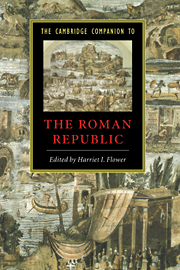Book contents
- Frontmatter
- Introduction
- PART 1 POLITICAL AND MILITARY HISTORY
- 1 The Early Republic
- 2 Power and Process under the Republican “Constitution”
- 3 The Roman Army and Navy
- 4 The Crisis of the Republic
- PART 2 ROMAN SOCIETY
- PART 3 ROME'S EMPIRE
- PART 4 ROMAN CULTURE
- PART 5 EPILOGUE: THE INFLUENCE OF THE ROMAN REPUBLIC
- Timeline
- Bibliography
- Index
1 - The Early Republic
from PART 1 - POLITICAL AND MILITARY HISTORY
Published online by Cambridge University Press: 28 May 2006
- Frontmatter
- Introduction
- PART 1 POLITICAL AND MILITARY HISTORY
- 1 The Early Republic
- 2 Power and Process under the Republican “Constitution”
- 3 The Roman Army and Navy
- 4 The Crisis of the Republic
- PART 2 ROMAN SOCIETY
- PART 3 ROME'S EMPIRE
- PART 4 ROMAN CULTURE
- PART 5 EPILOGUE: THE INFLUENCE OF THE ROMAN REPUBLIC
- Timeline
- Bibliography
- Index
Summary
Origins will always fascinate. By 264 B.C. Rome was already governed by means of most of the constitutional arrangements that are familiar to us from the 'classical' period of republican history; in that year it both completed the subjugation of peninsular Italy by capturing Volsinii (modern Orvieto) and began the process of Mediterranean conquest by sending its legions across the Straits of Messina into Sicily. Yet c. 509 B.C. it was just a large city in Latium with a constitution as yet undeveloped after emergence from a long period of monarchical rule. This chapter considers the origins of the Roman Republic and attempts to explain how the Latin city transformed itself into a nation ready and willing to grasp the prize of empire.
Before we begin, we must confront briefly the greatest problem in the study of early Rome, the notorious unreliability of our sources. They are almost entirely literary, and among them Livy, the only surviving writer to present a detailed narrative of most of the period, is preeminent. The reasons for this unreliability are easily explained: the Republic began c. 509 B.C., whereas Fabius Pictor, the first Roman historian, wrote c. 200; he and his successors in the second century B.C. had only very incomplete evidence, especially for the early period; many of Pictor's successors distorted what little material they had by reconstructing the history of early Rome so that it read like a history of their own times; and Livy unfortunately based his account on these writers rather than on the original evidence.
- Type
- Chapter
- Information
- The Cambridge Companion to the Roman Republic , pp. 15 - 30Publisher: Cambridge University PressPrint publication year: 2004
- 5
- Cited by

